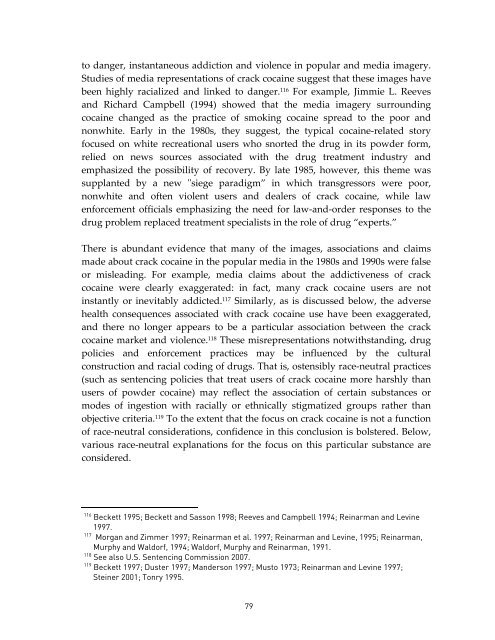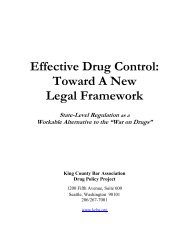RACE AND THE ENFORCEMENT OF DRUG DELIVERY LAWS IN ...
RACE AND THE ENFORCEMENT OF DRUG DELIVERY LAWS IN ...
RACE AND THE ENFORCEMENT OF DRUG DELIVERY LAWS IN ...
Create successful ePaper yourself
Turn your PDF publications into a flip-book with our unique Google optimized e-Paper software.
to danger, instantaneous addiction and violence in popular and media imagery.<br />
Studies of media representations of crack cocaine suggest that these images have<br />
been highly racialized and linked to danger. 116 For example, Jimmie L. Reeves<br />
and Richard Campbell (1994) showed that the media imagery surrounding<br />
cocaine changed as the practice of smoking cocaine spread to the poor and<br />
nonwhite. Early in the 1980s, they suggest, the typical cocaine-related story<br />
focused on white recreational users who snorted the drug in its powder form,<br />
relied on news sources associated with the drug treatment industry and<br />
emphasized the possibility of recovery. By late 1985, however, this theme was<br />
supplanted by a new "siege paradigm” in which transgressors were poor,<br />
nonwhite and often violent users and dealers of crack cocaine, while law<br />
enforcement officials emphasizing the need for law-and-order responses to the<br />
drug problem replaced treatment specialists in the role of drug “experts.”<br />
There is abundant evidence that many of the images, associations and claims<br />
made about crack cocaine in the popular media in the 1980s and 1990s were false<br />
or misleading. For example, media claims about the addictiveness of crack<br />
cocaine were clearly exaggerated: in fact, many crack cocaine users are not<br />
instantly or inevitably addicted. 117 Similarly, as is discussed below, the adverse<br />
health consequences associated with crack cocaine use have been exaggerated,<br />
and there no longer appears to be a particular association between the crack<br />
cocaine market and violence. 118 These misrepresentations notwithstanding, drug<br />
policies and enforcement practices may be influenced by the cultural<br />
construction and racial coding of drugs. That is, ostensibly race-neutral practices<br />
(such as sentencing policies that treat users of crack cocaine more harshly than<br />
users of powder cocaine) may reflect the association of certain substances or<br />
modes of ingestion with racially or ethnically stigmatized groups rather than<br />
objective criteria. 119 To the extent that the focus on crack cocaine is not a function<br />
of race-neutral considerations, confidence in this conclusion is bolstered. Below,<br />
various race-neutral explanations for the focus on this particular substance are<br />
considered.<br />
116 Beckett 1995; Beckett and Sasson 1998; Reeves and Campbell 1994; Reinarman and Levine<br />
1997.<br />
117<br />
Morgan and Zimmer 1997; Reinarman et al. 1997; Reinarman and Levine, 1995; Reinarman,<br />
Murphy and Waldorf, 1994; Waldorf, Murphy and Reinarman, 1991.<br />
118<br />
See also U.S. Sentencing Commission 2007.<br />
119 Beckett 1997; Duster 1997; Manderson 1997; Musto 1973; Reinarman and Levine 1997;<br />
Steiner 2001; Tonry 1995.<br />
79

















